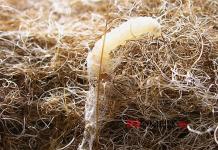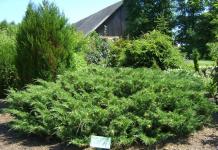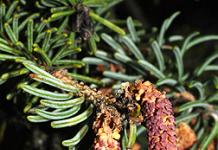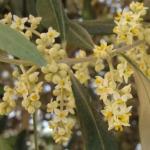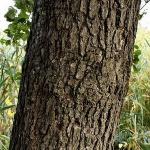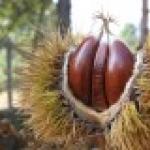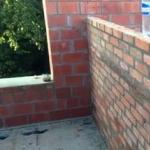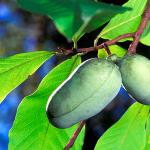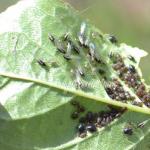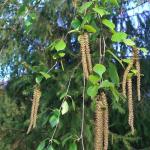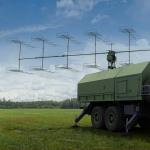Cossack juniper is the most unpretentious and widespread representative of this genus. It is represented by a creeping shrub that can reach a height of one and a half meters and a width of more than 20 cm, while rooting branches.
This plant is especially in demand by landscape designers, as it does not require specially treated soil and is tolerant of heat, frost, drought and winds. Moreover, this type of juniper has strong phytoncidal properties, killing all microbes in the environment.
In the first few years, young, newly planted bushes will require more labor-intensive and careful care than mature plants.
During the growth process, juniper should be watered regularly, especially on dry days. Juniper loves shallow loosening, since too compacted soil is undesirable for it.
Such a bush can grow without special fertilizer, but fertilizing it with nitroammophos or other complex fertilizer will not hurt, and it is worth doing this in early spring.
Cossack juniper also takes well to spraying, or, as it is also called, sprinkling. This procedure must be done once a week in the evening.
As a result of such an event, the bark of the branches should be well wetted. Proper spraying will help the bush grow beautiful and fresh needles. In winter, it is enough to just brush off the snow from the branches.
Planting Cossack juniper
It is best to plant such a plant in the spring. The main condition is that the site must be dry, and the chosen location must be located away from groundwater in a well-lit place.
Cossack juniper bushes should be planted at a distance of at least half a meter from each other.
The hole for planting should be dug several times larger than the roots of the plant. At its bottom you need to arrange drainage from sand, stones or broken bricks.
If we are talking about acidic soils, then it is necessary to add dolomite flour or lime.
The soil is loosened well, the roots are placed in the hole so that the upper edge is flush with the ground. Everything is covered, but the root collar remains outside.
Reproduction of Cossack juniper
Varietal junipers can be propagated only by cuttings; this is the only way to reproduce all the features and characteristics of the variety. Wild species can also reproduce using seeds that emerge after sowing in open ground after 1-3 years.
It is best to choose cuttings from perennial shoots, breaking off young branches with a heel. This should be done either at the end of April or at the end of May in cloudy weather conditions.

The cuttings must take root in the greenhouse for three months. But it is best to plant two-year-old seedlings in a permanent place.
In the first year, during the winter they must be covered with special material so that they do not freeze and do not suffer from the bright spring sun.
Juniper also reproduces very well by layering.
The use of Cossack juniper in the garden
This plant looks wonderful in the form of large green spots, especially against the background of stones and snow cover, because even in winter this bush does not lose its decorative features.
It is used to create hedges, in group and single plantings. When you rub or damage the needles, you can feel an unpleasant, pungent odor, which distinguishes it from other varieties.
This aroma arises from the poisonous essential oil contained in juniper.
Video “Cossack juniper “Glauca” - video review”
Video “Cossack Juniper – video review”
Cossack juniper - propagation
Recently, many amateur gardeners, in addition to fruit and berry crops, have been planting ornamental plants on their plots, as they say, “for the soul and to please the eyes.” Among them, a special place is given to coniferous evergreen trees and shrubs. Due to its unpretentiousness and frost resistance, Cossack juniper is the most popular among gardeners. But the trouble is, seedlings of these crops cost a lot of money. Okay, if you plant one plant, but if you want to plant a hedge of conifers. In this case, you can try to grow seedlings yourself. Cossack juniper is a dioecious plant. The male flower looks like an oval earring with numerous stamens: the female flowers are collected in an inflorescence. The cones are small, spherical, no more than 7 mm in diameter, brown-black with a bluish coating, drooping. Seeds ripen twice per season - in autumn and spring of the following year. Each cone contains no more than 4 seeds. Be careful, they are poisonous and Cossack juniper cannot be used for medicinal purposes.
Propagation by seeds
The most difficult and time-consuming option for propagating Cossack juniper is by seeds. From the resulting juniper fruits - cones, you can get seeds for sowing; to do this, you need to remove the seeds from the fruit and wash them; for quick germination, they can be immersed in a sulfuric acid solution for 10 minutes. To grow a juniper bush from a seed, it is necessary to stratify it. The best way is to sow seeds in boxes with soil in the fall. Then natural stratification - the boxes are taken outside and stored under the snow during the winter for 4-5 months, and already in April the overwintered seeds are sown in the beds.
Modern landscape compositions are rarely complete without luxurious Cossack juniper bushes. Planting a plant and caring for it is not difficult, and the ephedra looks very impressive, especially in groups. An evergreen creeping shrub enhances any garden plot and spreads a fresh and pleasant aroma.
Description of the plant
This unpretentious coniferous shrub of the Cypress family is loved by gardeners for its high decorative value and resistance to frost, drought and air pollution from smoke and gases. Creeping juniper loves bright places, is undemanding to the type of soil, and grows quickly, forming picturesque thickets. In nature, juniper is common in Europe and Asia.
Typically, Cossack juniper bushes are low, up to 1.5 m, with shoots creeping along the ground and spreading roots. Young plants and branches that are in the shade are distinguished by needle-shaped, pointed needles, up to 6 mm in length. On old bushes, the branches are covered with scales, layered on top of each other like tiles. Essential oil of pine needles has a pungent odor.
Essential oils and juniper berries are poisonous!
Cossack juniper is a dioecious plant; male (oval catkin) and female (inflorescence) flowers are located on different bushes. The fruits are small, up to 7 mm, brown-black cones with a bluish bloom. The fruit contains 3-4 seeds that contain poison.

Shrub varieties
Now there are more than 70 varieties of creeping juniper, which differ in the color of the needles or the shape of the crown. The most popular ones spread quickly in parks and gardens.
- Tamariscifolia
A low plant, up to 1 m, with a crown width of about 2 m. On outstretched branches there are vertical shoots with dark green bluish needles. The variety has been cultivated since the 18th century and has been growing for 30 years.
- Variegata
Brought out in the middle of the 19th century. It is distinguished by a compact, up to 1.5 m in diameter and 50 cm in height, funnel-shaped flat-round crown. The shoots are spread out with beautifully curved tops and individual cream-colored needles against a general bright green background. It grows quite slowly - 10-15 cm per year. It is successfully used in rockeries.
- Rockery Jam
A dwarf shrub, up to 0.5 m in height, with a crown diameter of up to 3 m, bred in Holland. This variety of Cossack juniper is characterized by blue-green prickly needles and slow growth in height. A ten-year-old bush rises to 20 cm, the crown spreads over 2 m.
- Blue Danube
This variety of creeping juniper was bred in Austria in the mid-twentieth century and in its name conveys the pearl of nature of this country - “Blue Danube”. The light bluish-blue needles of the shrub with curved tops cover an area up to 3 m in diameter. Shoots reach a height of 30-50 cm, sometimes even higher.
- Erecta
A tall bush of drought-resistant Cossack juniper was bred at the end of the 19th century in Holland and grows up to 2 m. Obliquely growing vertical branches with dark green scales create the shape of an inverted pyramid.
The monotonous appearance of plantings of one juniper, albeit of different varieties, can have a depressing effect on the mood. They must be diluted with decorative foliage or beautifully flowering plants.

Other low growing varieties
Among the most common low-creeping bushes of Cossack juniper are:
- Arcadia - winter-hardy, with horizontal shoots forming ridges, light green needles, crown width 1.5 m;
- Broadmoor - gray-blue needles, crown width 3.5 m, flat shape in the center becomes arched;
- Cupressifolia is a profusely fruiting female form with green-bluish needles;
- Nana is a drought-resistant male form, grows up to 0.8 m, dark green in color.

Tall varieties
In addition to Juniper Erecta, there are many other tall shrubs.
- Fastigiata - narrow columnar bright green crown reaches 6-8 m.
- Femina is a frost-resistant and durable female form that grows up to 1.5 m. It is distinguished by dark green, dense, unpleasant-smelling needles, spreading over 4-5 m.
- Mas is the male form of juniper, but older bushes bear fruit. Height up to 2 m, width - 5-8 m. The needle-shaped needles are bluish on top, green below, and become faintly purple in winter.
- Glauka - rises up to 1 m, spreads up to 2 m. The needles are blue-green, with a reddish tint in winter.

Decorative purpose
All types of creeping juniper are used in garden design, because it has undeniable decorative qualities. Such plantings create a special coziness and are distinguished by their elegant shape. Various shades of greenery from several varieties collected together also look attractive.
There are many uses for juniper:
- planting on the edges of the garden and on lawns;
- ground cover plantings of low-growing varieties on slopes;
- creating hedges, screens or decorating buildings, fences from tall species;
- an element of the Scandinavian style - against the background of large stones or buildings covered with moss, in the vicinity of the plots;
- tall varieties in bluish-silver tones are a good background choice for a discreet English garden;
- low-growing, monochromatic bushes will fit into the bizarre shapes of a Japanese garden;
- Planting juniper along with spruce, pine, and larches will add strict solemnity to the garden.
Cossack juniper does not go well with trees that have large leaves or with large flowers.
How to plant juniper?
For all types of Cossack juniper, it is necessary to choose a sunny place without nearby groundwater. A little shade is acceptable for several hours.
Juniper is also planted in September, but the best time for planting is in April. The roots of the seedlings are soaked in water and treated with growth stimulants. The most suitable soil acidity is 4-7 pH.
The landing algorithm is as follows:
- dig a hole that is 2-3 times larger than the size of the roots;
- part of the excavated soil is mixed with 2 parts of peat, 1 part of sand and 100 g of lime or 200 g of dolomite flour are added;
- drainage 15-20 cm high is placed at the bottom of the hole;
- the plant is placed so that the neck rises 5-10 cm above the soil;
- after the soil has been compacted, it is watered abundantly and sprinkled with a thick layer of peat on top.
At least 0.5 m of space is left between juniper seedlings.

Watering and fertilizing
The seedling must be provided with careful care.
- After planting, in May, feed 30 g of nitroammophoska per 1 square meter. m or dissolve 20 g of Kemira-Lux universal fertilizer in 10 liters of water.
- Feeding juniper is repeated every spring.
- For better care, foliar feeding with Epin is recommended.
- In the spring and summer heat, water 10-30 liters per plant 2-3 times per season, making a groove around the perimeter of the hole.
- In the evening, after the sun, spray the juniper crown with water once a week.
- It is advisable to shade young seedlings at temperatures above 35 degrees.
- For preventive care, the crown is periodically treated with fungicides.
- For the winter, seedlings are covered with mulch.
Trimming
Amateur gardeners should remember that all parts of the Cossack juniper contain poison - sabinol essential oil. Scratches received during pruning may hurt for a long time and itching will be felt.
Pruning is carried out in spring or autumn at a temperature of +4 0 C.
- For shrubs, sanitary pruning is carried out, removing dry or damaged branches.
- Formative pruning of juniper is possible for an aesthetic appearance of the crown: in the process, the direction of the branches is changed, the growth of shoots is stopped or a certain silhouette is created. Cut off no more than 2 cm of shoot.
The effect of branching the crown is observed when pinching the tips of the shoots.

Diseases and pests
Preventive treatment of bushes with fungicides is designed to protect young plants from fungal diseases to which they are often susceptible.
- To avoid infection with rust, juniper is not planted next to plants of the Rosaceae family.
- The roots of young plants suffer from fusarium, the needles turn yellow, and the shoots wither. The crown is sprayed with “Fundazol” and the soil is watered with the same solution.
- Juniper bushes die in winter from brown chute: a black sticky mycelium is noticeable on the brown needles. The affected parts are removed and the plant is sprayed with Abiga-Pik and HOM.
- Juniper is also affected by Alternaria blight, nectriosis, bark cancer and other diseases, which are most often expressed by yellowing and falling of the needles. Treatment with antifungal drugs is effective.
Pests usually fly around poisonous shrubs. Sometimes scale insects and spider mites settle in, which are controlled with insecticides.
A well-placed shrub or an entire juniper grove will decorate the garden. The plant is capable of purifying the air and requires very little attention.
Cultivated, propagated exclusively by cuttings. Moreover, according to experienced gardeners, this technique has a number of advantages relative to the method of seed propagation. Plants planted by rooting cuttings have significantly higher stability and viability. They take root better, develop faster and more actively, and are less susceptible to the adverse effects of temperature changes, typical diseases and pests.
Moreover, according to statistical data, the number of successfully rooted cuttings is almost twice as large as the number of surviving seedlings. Therefore, according to gardeners and landscape designers, this method of propagating juniper under artificial conditions is the most effective. A plant planted in the ground by cuttings acclimatizes better and adapts to new conditions, without requiring special care and attention. However, to achieve extremely favorable results, you must follow some rules.
Assessing the favorable time for disembarkation
Should be carried out in the fall and winter months. However, knowledgeable people recommend planting plants from mid-September to the last ten days of November. During this period, the stomata of plants close due to the increased degree of air humidity, as a result, practically no evaporation of water occurs, which has a beneficial effect on the condition of the tree and the reproduction process.

In spring and summer, it is strictly not recommended to plant juniper. This is due to damage to the root system, which is caused by increased evaporation and physiological drought observed in coniferous plants in the warm season. However, the question of the optimal timing of planting juniper trees is quite controversial. Many gardeners claim that the time from the first days of April to the end of May is ideal for organizing the propagation of juniper by cuttings, since this period is the peak of its growth and development in the fall.
When determining planting dates, you should also pay attention to climatic conditions. In order for the rooting of juniper cuttings to be successful, the air temperature should be from +5 to +25 degrees. Higher or lower heat levels can have an adverse effect on the plant's reproduction process and lead to its death.
Preparing soil and cuttings
To grow a beautiful and healthy juniper tree, you should take a responsible approach to collecting planting material. For plant propagation, cuttings taken from mature trees that are 8–10 years old are best suited. As for the choice of variety, it is best to give preference to low-growing or common juniper; their rooting rate is about 90%. Please note that in plants with a vertical crown shape, shoots for propagation are cut vertically. In junipers with a bush-shaped crown, cuttings located on the sides are used for cutting. As for the length of the shoot, it is advisable to maintain 10–15 cm.

It is recommended to cut cuttings no later than three hours before planting in the ground. Then their lower part should be cleared of pine needles, which can rot if they get into the soil. In addition, it increases the efficiency of growth and development of the root system. However, the needles must be left on the top of the branches in order to aerate the cuttings. Before planting, the shoots are placed in a container filled with water, or they can be wrapped in a damp cloth. To speed up the growth process of the future juniper tree, the cutting can be placed in a glass with a special stimulating solution for a day. Kornevin or a sugar solution in a 1:2 ratio is well suited for these purposes.
Next, you can move on to preparing the soil for growing juniper. Planting soil should be a mixture of soil with peat and sand (in a ratio of 1:3). Juniper, like other conifers, does not do well in overly acidic soils. You can reduce acidity and also carry out disinfection by moistening the soil with a concentrated solution of potassium permanganate. When the planting soil is ready, dig a hole, fill it with solution, and place a layer of sand about 30–35 mm thick on top.
How to plant a young shoot correctly?
After completing the preparatory stages, you can proceed to the actual planting of juniper. To do this, planting material should be placed in the soil no deeper than 20–25 mm. At the same time, pay attention to the fact that columnar varieties of juniper are planted in a vertical position, without turning the cuttings, and creeping varieties of this plant take root best when there is a slight slope. The distance between the cuttings should be about 70 m. After this, you should slightly squeeze and moisten the soil. Finally, the ground is mulched with a mixture of ash and pine bark, and the cuttings themselves are covered with plastic film, this is important for creating a greenhouse effect. In order for the tree to take root and acclimatize as quickly as possible, it needs to create optimal conditions for this.

Care consists of regular moisturizing, which is necessary to strengthen the plant. It is necessary to water the cuttings as the soil dries out, on average twice a week. Care must be taken to protect the plant from sunlight. Despite the fact that juniper is considered a light-loving plant, during the development of its root system and general adaptation, direct sun can have an extremely adverse effect on it. Rooting of juniper lasts about 2–3 months. At the same time, it is recommended not to rush into transplanting the plant into open ground in order to give it the opportunity to finally get stronger.
Cossack or Don juniper (lat. Juniperus sabina) - a creeping evergreen shrub of the Cypress family with scaly needles in adults and pointed needle-shaped needles in young plants, thanks to its decorativeness, rapid growth and unpretentiousness, has become one of the most popular elements of landscape design.
How to plant Cossack juniper?
In favorable conditions, the bushes reach 1 to 2 m in height, growing mainly in breadth and forming dense, picturesque thickets. In its natural environment, Cossack juniper is distributed in the poor soil of steppes and sandstones, rocky mountain regions of the south and center of Europe, the Caucasus, Siberia, and Asia.
Today, about 80 varieties and subspecies of Cossack juniper are known, which are successfully used in landscaping gardens and summer cottages, city parks and public gardens. Individual bushes look impressive in mixborders in compositions with flowering, coniferous and deciduous plants; those planted in a group look great in rock gardens and rock gardens; those planted in a row can play the role of a decorative hedge.
For single bushes and compositions, it is necessary to choose a spacious, well-lit area away from groundwater. A rocky sunny slope or a slightly shaded area in the southern or southeastern part of the garden is perfect.
How to prepare a place and soil for seedlings
For seedlings purchased from a nursery or grown on your own, you should prepare holes twice the size of the root system of each plant.
- Pour a thick drainage layer of sand, perlite, brick fragments, and expanded clay onto the bottom of the hole.
- Junipers are not picky about the composition of the soil, but it is advisable to add a little dolomite flour or lime to overly acidic soil. Fertilizing the soil with products for conifers will help you grow a full-fledged plant with a beautiful crown, healthy needles and a developed root system.
- Place the entire length of the roots of the seedlings in the hole, cover with loosened soil, leaving the root collar open.
- Make a depression for watering and mulch the surface with pebbles, expanded clay, crushed stone, sawdust, crushed bark, sand to maintain a comfortable environment and protect the roots from excess moisture and drying out, overheating and hypothermia.
- If you plan to plant a group of plants, the intervals between the holes should be at least three meters so that the crowns of the grown bushes do not interfere with the neighboring ones.
Reproduction issues
Cossack juniper is propagated by seeds, which are extracted from the cone-berries of the plant, and by cuttings. Seedlings of Cossack juniper of different varieties can be purchased from private traders and nurseries, making sure that the seller is reliable.
Propagation by seeds
Propagation by seeds is a rather complex, lengthy process that requires some skills in processing planting material.
- The cone-berries should be placed in a warm, dry place, the seeds should be removed when the fruits open, and after rinsing with running water, stratification, that is, maintain for 3-4 months or longer at a constant temperature not higher than +20°C. In some cases, seeds should be stratified for at least a year, after which they are sown directly into the ground in late autumn. As practice shows, this method does not always guarantee successful germination. At best, the germination process can take two to three years.
- You can grow seedlings using the snowing method, in which prepared seeds should be sown in containers with soil at the beginning of winter and left under the snow in the open air. In spring, containers can be moved indoors and covered with film. Seedlings grown in this way are planted two years later in open ground in early spring, as soon as the snow melts.
Reproduction by cuttings and layering
Propagation by cuttings is much faster, more efficient and economical.
- It is recommended to prepare cuttings in early spring in cloudy weather, using a sharp knife to carefully separate healthy branched growths 10-30 cm long from the mother bush, treating the “heel”, a piece of bark with wood from an old plant, with a root growth stimulator and placing it in a substrate of river sand, conifers sawdust and black soil in equal proportions. The rooting process lasts about three months, during which the cuttings must be regularly watered and sprayed.
- When growing seedlings in a greenhouse, it is important to maintain a temperature regime no higher than +26°C.
- When propagating by layering, in late autumn you should select the lower branches creeping along the ground, make small cuts, treat them with a stimulator for the formation and growth of roots, and sprinkle them with earth. By spring, roots appear on the treated cuts. Cut off cuttings with roots and plant them in prepared holes.
Rules for caring for juniper
Cossack juniper does not require special care, since it is characterized by good adaptability to adverse environmental factors and endurance in comparison with other types of junipers and coniferous shrubs.
- Mature bushes tolerate drought well, but for growth and development it is advisable to water and spray them abundantly. Procedures must be carried out in the evening so as not to burn the needles. Regular shallow loosening of the soil at the roots and removal of weeds that impede air access to the root system have a beneficial effect.
- It is recommended to apply complex nitrogen-phosphorus fertilizers to poor soil in early spring, repeating the procedure after a month and a half. It is advisable to use growth stimulants for foliar feeding.
- In soil rich in humus or loam, it is necessary to add several buckets of sand, since the fatty composition of the soil leads to oppression of plants.
- Young plants need to be shaded in early spring and during dry seasons. Bushes planted in open spaces in late autumn should be covered at the roots with a thick layer of sawdust and the crown should be wrapped in lutrasil (non-woven protective fabric).
Transplantation - how to do it right?
Transplanting an adult plant is always fraught with risk, since it is almost impossible to guess how wide and deep the root system is so that you can dig around it from all sides without touching it. In addition, juniper may not tolerate stress. Young healthy plants without signs of disease or damage take root much faster:

Diseases of Cossack juniper
Cossack juniper is quite resistant to most common diseases of garden plants, but it is necessary to carefully inspect the crown and table from time to time to avoid unpleasant consequences.
 Cossack juniper is usually pruned when branches grow too rapidly and to remove sun-damaged and dry branches, but if desired, bushes and hedges can be given any shape.
Cossack juniper is usually pruned when branches grow too rapidly and to remove sun-damaged and dry branches, but if desired, bushes and hedges can be given any shape.
- The formation of a bush should be done very carefully, since pruned branches can stop growing and disfigure the plant.
- Pruning should be carried out in spring or autumn at a temperature no higher than +4°C, no more than once a year.
- No more than 20% of new shoots are cut off.
- After pruning, it is advisable to spray the plants with an aqueous solution of Epina-Extra.
Medicinal properties of Cossack juniper
The medicinal properties of juniper are known, decoctions and infusions of the fruits and powder from the dried needles of which are still used today for treatment:
- diseases of the genitourinary system;
- upper respiratory tract;
- digestive organs;
- helminthiasis;
- diseases of the nervous system;
- hysteria;
- epilepsy;
- joint diseases;
- paralysis;
- boils;
- eczema;
- purulent lesions of the skin and mucous membranes;
- skin lesions due to radioactive radiation;
- partial and complete alopecia.
Branches of Cossack juniper are used for fumigation of premises during periods of epidemics.
In contact with
